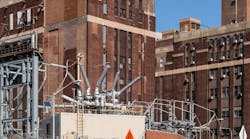Over the last several years there have been several great articles regarding substations being converted from analog to partially or entirely digital. One of my favorites was a story about the refurbishment and upgrade of a Con Ed substation in Lower Manhattan damaged during Hurricane Sandy. I think it is my favorite because I actually saw the damage Con Ed experienced from the storm, so the significance of this upgrade and the storm-hardening measures Con Ed put in place are very tangible for me. The digital upgrade included a new elevated design with a modular 420 kV Plug and Switch System (PASS) hybrid switchgear.
Another press article covered an earlier, but more extensive digital endeavor. The Future Intelligent Transmission Network Substation (FITNESS) project is being developed by SP Energy Networks in Scotland. This project utilizes ABB grid automation technology, which will enable a digital substation scheme to protect, monitor and control the transmission network. The project involves retrofitting two bays of the existing Wishaw 275-kV substation in Scotland with new fully integrated digital protection and control systems. The region surrounding the Wishaw substation is of special interest due to the presence of large quantities of potential wind power capacity. ABB will deliver a suite of digital substation components for the retrofit, including Intelligent Electronic Devices (IEDs), non-conventional instrument transformers, merging units, and phasor measurement units that are interfaced with the IEC 61850-9-2 process bus architecture and with the wide area monitoring platform.
T&D World Grid Optimization intends to start a regular column focused on digital equipment and substations. We are surprised by the lack of technical coverage that surfaces regarding digital substation projects and advancements. Few observers will disagree that the digital revolution on the grid and particularly in substations took off with the publishing of IEC 61580 in 2003. Some of the attributes of IEC 61850 and some of the magic that make it timeless are described in an article titled: “Why GOOSE is Just the Tip of the Iceberg - A holistic view on IEC 61850 business case."
This same article also describes key evolutionary milestones of the digital substation. The first major identifiable milestone may be the transformation from a wired to an optical communication network. Another major milestone is the evolution of the current and voltage transformer from conventional current transformers (CTs) and voltage transformers (VTs) to Non-Conventional Instrument Transformers (NCITs). Some digital forensics experts will argue that the next evolutionary step was combined current and voltage NCITs for metering and protection. Not everyone agrees on all of the evolutionary stages or the exact timeline, but most agree our progress to date was possible due to the standardized integration of protection, control and metering with the IEC 61850 standard.
In addition, many designers will agree that a hybrid or digital substation will have most of the following elements: a substation automation protection and control (P&C) system with IEC 61850 station bus; a communication system; an IEC 61850 process bus which connects the switchyard to the P&C system; transition devices which bridge the gap between the analog and digital components; and NCITs.
The power industry has spent a tremendous amount of time and money digitalizing the power system since IEC 61850 came on the scene. All the while, digital substation technology has been improving as well. Digital substation advantages today include:
- A high percentage of standardized and factory tested panels and components which contribute to shorter manufacturing and customization lead times and greater flexibility to modify the system late in the development/construction cycle.
- A reduction in copper cable by up to 80%. IED control wiring is replaced by fiber optic communications between IEDs. This reduces material cost, transportation cost, construction time and independent connections that can later require maintenance.
- Space requirements are reduced by 30 to 60%. This includes reduced space for protection and control panels, conventional IO’s and CT/PT inputs. On the primary side, the reduction of the switchyard footprint can be up to 50% using circuit breakers with integrated disconnecting functionality and optical current sensors.
- Less installation and outage time. The installation time for new P&C systems can be reduced as much as 40% with corresponding reductions in feeder outage time.
- Increased safety. Personnel safety is improved since copper control wires and conventional instrument transformers are replaced with fiber optic communications and optical measurement devices.
- Effective and easier maintenance through automatic monitoring. Sensors, electronics and software monitor the status of the primary and as well the secondary devices of a substation for the optimization of maintenance activities.
Our smart grid is becoming more and more sophisticated every day because the demands being put upon the grid and our substation control and protection systems are constantly multiplying. It is hard to imagine that the system will be unable to keep up, that is if we build the intelligence we are gaining into our new and retrofitted systems and share our successes. We look forward to sharing what our industry is doing to digitalize our electric system.


